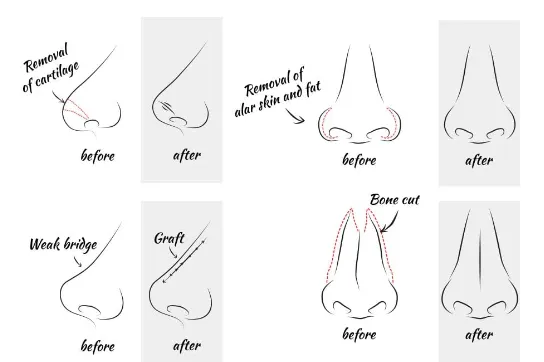Nose job, a common term for rhinoplasty, is a transformative nasal surgery that falls under the umbrella of both cosmetic and plastic surgery. Tailored to address diverse nasal types, including bulbous, Roman, and crooked noses, rhinoplasty offers individuals the opportunity to enhance both the aesthetic appearance and functional aspects of their nose. By utilizing advanced surgical techniques and personalized approaches, rhinoplasty can achieve harmonious nasal symmetry and contouring, ultimately empowering patients to achieve their desired facial aesthetics.
Different Types of Noses
The nose plays a significant role in defining our facial features, and for many individuals, its shape or size may cause self-consciousness or dissatisfaction. Fortunately, advancements in cosmetic surgery have made it possible to alter the appearance of the nose through rhinoplasty, commonly known as a “nose job.”
In today’s world, where physical appearance is often emphasized, many individuals consider cosmetic procedures to enhance their features and boost their self-confidence. One such procedure that has gained popularity is the nose job, medically known as rhinoplasty.
A nose job involves reshaping the nose to achieve a more harmonious facial balance and address functional concerns. This article explores the concept of nose jobs, their various aspects, and important considerations for those considering the procedure.
This article will explore various types of noses and how rhinoplasty can be tailored to address specific concerns, including fleshy noses, Roman noses, and even fantasy-inspired nose jobs. Additionally, we will discuss the importance of nasal reconstruction for individuals who have experienced trauma or congenital abnormalities. Let’s delve into nose jobs and how they can help individuals achieve facial harmony.
The term “Different Types of Noses” refers to the diverse range of nasal shapes and structures found among individuals, each influenced by genetic factors, ethnicity, and anatomical variations. Some common types of noses include:
Clinic contact number: +989371200167
Fleshy Nose job
A fleshy nose is characterized by excess soft tissue, particularly in the nasal tip. It often appears round or bulbous, lacking the defined contours that many desire. Rhinoplasty for fleshy noses focuses on refining the nasal tip, reducing excess cartilage, and reshaping the nose to achieve a more balanced appearance. Surgeons employ cartilage reshaping, tip refinement, and sometimes even nostril reduction to create a refined, natural-looking nose that harmonizes with the overall facial aesthetics.
Tip Refinement
One of the primary goals of rhinoplasty for a fleshy nose is to refine the nasal tip to reduce its fullness and create better definition. This may involve reshaping and sculpting the cartilage in the tip to create a more defined and angular contour. By addressing excess soft tissue and refining the nasal tip, rhinoplasty can achieve a more proportionate and aesthetically pleasing nasal shape.
Nasal Bridge Sculpting
In some cases, the nasal bridge of a fleshy nose may appear wide or bulbous. Rhinoplasty can involve narrowing the nasal bridge by removing excess bone and cartilage or performing osteotomies to reposition the nasal bones. This helps to create a more balanced and harmonious profile, enhancing the overall appearance of the nose.
Roman Nose job
The Roman nose, often associated with strength and character, features a prominent and slightly convex bridge, creating a distinguished appearance. Rhinoplasty for Roman noses aims to bring harmony by reducing the nasal hump, refining the tip, and reshaping the bridge. By meticulously sculpting the nasal structure, the surgeon can achieve a more balanced and aesthetically pleasing nose that retains the unique character of the Roman nose.
Fantasy Nose Job
Inspired by the world of imagination, some seek a nose that stands out and evokes a sense of fantasy. A fantasy nose job offers a range of possibilities, allowing for unique shapes, sizes, and contours that deviate from conventional norms. From a whimsical upturned tip to a delicate and ethereal appearance, a fantasy nose job allows individuals to express their creativity and individuality. Skilled surgeons work closely with patients to transform their vision into reality while ensuring functionality and facial harmony.

Nasal Reconstruction
Nasal reconstruction is a specialized branch of rhinoplasty that focuses on restoring the form and function of the nose for individuals who have experienced trauma, congenital abnormalities, or previous unsuccessful surgeries. It requires intricate surgical techniques and a deep understanding of nasal anatomy.
Whether the nasal deformity is caused by injury, birth defects, or cancer, nasal reconstruction aims to rebuild the nose, improve breathing, and restore the patient’s confidence. Surgeons utilize reconstructive techniques, including tissue grafting, cartilage manipulation, and advanced suturing methods, to create a natural-looking and functional nose.
- Flap Reconstruction: Flap reconstruction involves transferring tissue from nearby areas, such as the forehead, cheek, or ear, to reconstruct nasal defects. Flaps may be pedicled, meaning they remain attached to their blood supply, or free, where the tissue is detached and reattached to the nose. This technique allows for the creation of a new nasal structure with adequate blood supply and tissue coverage.
- Cartilage Grafting: Cartilage grafting is often employed to provide structural support and contour to the reconstructed nose. Cartilage can be harvested from the septum, ear, or rib and used to rebuild the nasal framework, enhance tip projection, or correct deformities. This technique is crucial for achieving natural-looking results and maintaining long-term stability.
- Skin Grafting: Skin grafts may be utilized to cover larger defects or areas where local tissue is insufficient. Skin grafts are typically harvested from donor sites such as the thigh or abdomen and carefully placed over the nasal defect. Special care is taken to ensure proper graft adherence and vascularization to promote healing and minimize complications.
- Reconstructive Rhinoplasty: Reconstructive rhinoplasty involves reshaping and refining the reconstructed nose to improve aesthetics and symmetry. This may include refining the nasal tip, adjusting nasal contours, and addressing any residual asymmetries. The goal is to achieve a natural-looking nasal appearance that restores facial harmony and function.
- Microsurgical Techniques: In complex cases or when precise vascular anastomosis is required, microsurgical techniques may be employed. These techniques involve using specialized microscopes and instruments to perform intricate tissue transfers and vascular connections, ensuring optimal tissue viability and healing.
Perspectives from Prominent Experts and Active Healthcare Centers
Rhinoplasty for different types of noses, including bulbous, Roman, and crooked noses, has been advanced through the expertise of renowned surgeons and research conducted at leading institutions such as Stanford University School of Medicine and the Johns Hopkins University School of Medicine.
Esteemed figures in this field, such as Dr. Dean Toriumi of the University of Illinois at Chicago and Dr. Rod Rohrich of the University of Texas Southwestern Medical Center, have contributed significantly to the development of innovative rhinoplasty techniques. Their research on nasal anatomy, surgical approaches, and outcomes has helped refine surgical methods and improve patient satisfaction rates.
Among the most active hospitals in rhinoplasty is the Mayo Clinic, recognized for its excellence in facial plastic and reconstructive surgery. With state-of-the-art facilities and a multidisciplinary team of experts, the Mayo Clinic offers comprehensive care for patients seeking rhinoplasty procedures.
According to recent statistics from the American Society of Plastic Surgeons, rhinoplasty remains one of the most commonly performed cosmetic surgical procedures, with over 213,000 procedures performed in the United States alone in 2020. This demonstrates the continued demand for rhinoplasty and the importance of ongoing research and advancements in the field to meet patient needs and expectations.
Clinic contact number: +989371200167

Different types of Rhinoplasty
- Reduction Rhinoplasty: Focuses on reducing the size or reshaping the nose to create a more proportionate appearance.
Nasal surgery, specifically rhinoplasty for a bulbous tip, addresses cosmetic concerns related to nasal aesthetics. This specialized procedure focuses on reshaping the nasal tip to achieve a more refined and balanced appearance. Through cosmetic nose surgery, patients seek to enhance both the aesthetics and harmony of their facial features.
- Augmentation Rhinoplasty: Enhances the size or shape of the nose by adding volume or building up specific areas using grafts or implants.
- Ethnic Rhinoplasty: Preserves ethnic features while improving the overall appearance of the nose, respecting and enhancing unique characteristics.
- Reconstructive Rhinoplasty: Restores the form and function of the nose following trauma or previous unsuccessful surgeries.
- Revision Rhinoplasty: Corrects unsatisfactory results or complications from a previous nose job.
- Non-Surgical Rhinoplasty: Uses injectable fillers to reshape and enhance the nose without surgery, providing temporary adjustments.
Despite its widespread use, rhinoplasty is a complex procedure associated with certain risks and complications. The surgical procedure for reshaping the nose is refined to provide results that seem natural and facilitate a quick recovery. TC plastic surgery
Clinic contact number: +989371200167
Summary
In conclusion, rhinoplasty emerges as a versatile solution within the realm of nasal surgery, encompassing various techniques tailored for different types of noses. Commonly known as a nose job, this procedure represents a pivotal aspect of cosmetic surgery, offering patients the opportunity to achieve desired facial aesthetics through precise nasal reshaping.
By employing advanced rhinoplasty techniques, surgeons can address concerns associated with bulbous, Roman, and crooked noses, ultimately enhancing overall facial harmony and proportions. Through the lens of facial aesthetics, rhinoplasty transcends beyond mere cosmetic enhancement, allowing individuals to attain both physical and psychological well-being by sculpting their nasal contours to align with personal ideals.
Furthermore, the evolving landscape of rhinoplasty techniques underscores the continuous refinement and innovation within the field of nasal surgery. As the demand for nasal reshaping procedures grows, advancements in rhinoplasty techniques promise enhanced precision and tailored outcomes for patients seeking facial rejuvenation.
With a focus on optimal nasal reshaping and harmonious facial aesthetics, rhinoplasty remains a cornerstone of cosmetic surgery, empowering individuals to embark on transformative journeys towards self-confidence and fulfillment in their appearance.
FAQs
1. How long does it take to recover from a nose job?
The recovery time for a nose job varies from person to person, but generally, it takes around one to two weeks for the initial swelling and bruising to subside. However, complete healing and the final results may take several months as the nose gradually refines and settles into its new shape.
2. Are there any risks associated with rhinoplasty?
As with any surgical procedure, rhinoplasty has potential risks and complications.
3, Will a nose job affect my breathing?
A nose job can often improve breathing by addressing structural issues such as a deviated septum or nasal valve collapse.
4. Can rhinoplasty address the bulbous appearance of my nose?
Yes, rhinoplasty can effectively address bulbous noses by refining the nasal tip and reducing its roundness. Techniques such as tip sculpting and cartilage reshaping are commonly used to achieve a more defined and aesthetically pleasing nasal contour.
5. Will rhinoplasty for a bulbous nose involve removing bone or cartilage?
Depending on the individual’s anatomy and desired outcomes, rhinoplasty may involve removing excess cartilage, refining the nasal tip, and possibly performing osteotomies to narrow the nasal bridge. These techniques help create a more balanced and harmonious nasal appearance.
6. What can I expect during the recovery process after rhinoplasty for a bulbous nose?
The recovery process after rhinoplasty typically involves swelling, bruising, and discomfort, which gradually subside over several weeks. It’s essential to follow post-operative instructions provided by your surgeon, including avoiding strenuous activities and keeping the nasal area protected to promote optimal healing.
https://www.tcplasticsurgery.com/rhinoplasty/



